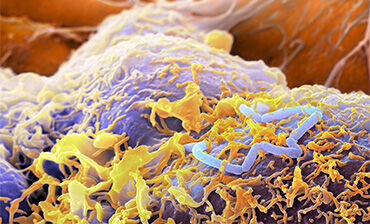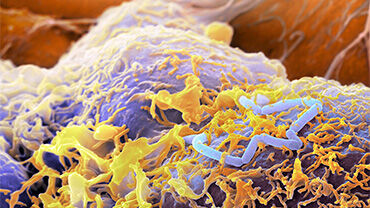Pioneering project describes molecular epidemiology of listeriosis in humans and Listeria monocytogenes in food
A collaborative study between ECDC, the European Food Safety Authority (EFSA) and the European Union Reference Laboratory (EURL) for Listeria monocytogenes* found a relatively high degree of dissemination of certain listeriosis bacteria in the food chain and in the human population across the European Union (EU). In particular, there was a strong link with ready-to-eat fish products in several of the listeriosis clusters identified

Listeriosis is a foodborne disease caused by L. monocytogenes bacteria. After ingestion of L. monocytogenes bacteria via contaminated food, infection can cause severe, life-threatening disease, often manifested as septicaemia and/or meningitis, particularly among elderly and immunocompromised people, as well as complications related to pregnancy.
The collaborative study, called ‘the European Listeria Typing Exercise’ (ELiTE), was initiated in 2010 with the aim of describing with a One Health approach the molecular epidemiology of listeriosis in humans and food in a two-year period. The study connected data about public health and food from 13 and 23 EU Member States, respectively. The study on L. monocytogenes in food was conducted on three categories of ready-to-eat food: packaged hot or cold smoked or ‘gravad’ (cured) fish, soft or semi-soft cheeses, and packaged heat-treated meat products.
The study has utilised molecular typing, which is a way of identifying specific strains of microorganisms, such as bacteria or viruses, by looking at their genetic material. The selected molecular typing method for this project, pulsed field gel electrophoresis (PFGE), was a well-established, standardised molecular typing method in both sectors at the time of the study and was therefore a natural choice.
PFGE as a molecular typing method is gradually phasing out and is being replaced by the state-of-the-art method of whole genome sequencing (WGS). The project has bridged the PFGE method with WGS method by mapping the clustering PFGE types with respective clonal complexes (CCs) characterised by WGS. This offers a unique reference with information from historical PFGE cluster types linked to WGS, thus enabling countries to make use of historical PFGE data to select isolates for further characterisation by WGS. A cluster means that isolates are genetically very similar, i.e. they most likely originate from a common source. If human and food isolates are gathered in the same cluster, it is a strong, but not definite, indication that the food may have caused the infections. Microbiological evidence alone is not sufficient to link the food with human infections, and supportive epidemiological evidence is always required.
There were 78 separate clusters by PFGE profiles, involving 573 (57.7%) L. monocytogenes isolates in the study dataset. Of these, 21 included both human and food L. monocytogenes isolates, 47 included only human, and 10 only food isolates. In the 21 human-food clusters, the majority of food isolates (89.7%) were from fish products, whereas the remaining ones originated from delicatessen meat products (9.3%) and cheese products (1.0%). The amount of Listeria in fish products was generally low, but in 48 fish samples Listeria counts exceeded the microbiological criterion of 100 cfu/g. These high-count fish samples represented 87.3% of all food samples (55) with Listeria counts exceeding 100 cfu/g.
Of 78 clusters by PFGE profiles, 57 (73.1%) were small, up to five L. monocytogenes isolates per cluster. The largest PFGE cluster was made up of L. monocytogenes clone CC8. The cluster involved 30 human and 56 food L. monocytogenes isolates from 15 countries, suggesting a high degree of dissemination of this clone in the food chain in the EU. In contrast, considering the capacity of Listeria to persist in the food chain for years, this clone is likely to eventually cause large cross-border food-borne outbreaks.
The results from this project show that the risk of L. monocytogenes in ready-to-eat fish products requires further attention. A review of the compliance of food business operators with regulatory microbiological criteria could be considered, particularly for fish products. In the EU and the European Economic Area (EEA) there is an increasing proportion of aged populations, and challenges related to assessing exposure in this group. A genetic library of food-derived L. monocytogenes isolates against which any human isolate could be compared could maximise the speed of source identification in outbreak investigations. The data collected in this study and the applied methodology provide a good background for such a library.
*Hosted by the French Agency for Food, Environmental and Occupational Health & Safety, ANSES







